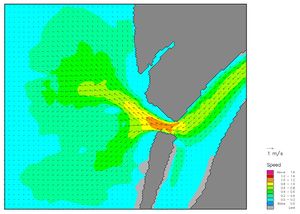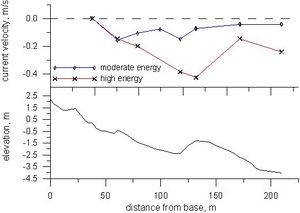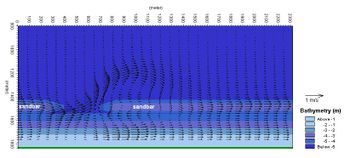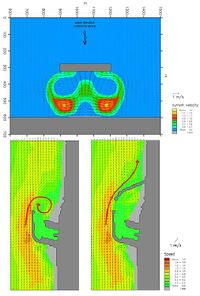Currents
The various types of currents in the sea, which may be important to coastal processes in one way or another, are described in the following.
Contents
Currents in coastal seas
Tidal
Tidal currents are strongest in large water depths away from the coastline and in straits where the current is forced into a narrow area. The most important tidal currents in relation to coastal morphology are the currents generated in tidal inlets. Typical maximum current speeds in tidal inlets are approx. 1 m/s, whereas tidal current speeds in straits and estuaries can reach speeds as high as approx. 3 m/s. Tides and tidal currents in coastal seas and estuaries are discussed in the articles Tidal motion in shelf seas, Ocean and shelf tides, Tidal asymmetry and tidal inlet morphodynamics, River tides.
Wind-generated
Wind-generated currents are caused by the direct action of the wind shear stress on the surface of the water. The wind-generated currents are normally located in the upper layer of the water body and are therefore not very important from a morphological point of view. In very shallow coastal waters and lagoons, the wind-generated current can, however, be of some importance. Wind-generated current speeds are typically less than 5 per cent of the wind speed.
Storm surge
Storm surge current is the current generated by the total effect of the wind shear stress and the barometric pressure gradients over the entire area of water affected by a specific storm. This type of current is similar to the tidal currents. The horizontal current velocity follows a logarithmic distribution in the water profile and has the same characteristics as the tidal current. It is strongest at large water depths away from the coastline and in confined areas, such as straits and tidal inlets.
Current in the Nearshore Zone
Nearshore mean currents which occur within the surf zone are principally driven by the breaking waves. For purposes of simplification, nearshore mean currents are usually separated into their cross-shore and longshore components: Undertows and rip currents have their principal axes oriented perpendicular to the beach (offshore) while longshore currents act parallel to the beach. These currents are all driven by cross- and/or longshore components of radiation stress gradients (in practive wave energy gradients) that arise through wave breaking.
Shore-parallel currents
The longshore current is the dominant current in the nearshore zone. The longshore current is generated by the shore-parallel component of the stresses associated with the breaking process for obliquely incoming waves, the so-called radiation stresses, and by the surplus water which is carried across the surf zone towards the coastline, as explained in Shallow-water wave theory. This current has its maximum within the breaker zone. During storms the longshore current can reach speeds exceeding 2.5 m/s. The longshore current carries sediment along the shoreline, the so-called littoral drift; this mechanism is discussed further in Coastal Hydrodynamics And Transport Processes and Littoral drift and shoreline modelling.
The longshore current is generally parallel to the coastline and it varies in strength approximately proportional to the square root of the wave height and with [math]sin(2\alpha_b) [/math], where [math]\alpha_b[/math] is the wave incidence angle at breaking. As the position of the breaking line constantly shifts due to the irregularity of natural wave fields and since the distance to the breaker line varies with the wave height, the distribution of the longshore current in the coastal profile will vary accordingly.
Shore-normal currents
Undertow
[1]The undertow is defined as a longshore homogeneous current flowing offshore near the seabed and it is driven by the cross-shore wave set-up gradient (representing radiation stress decay). The offshore discharge of water is compensated by the onshore directed mass transport and roller transport in the upper layers of the water column. Fig. 2. shows typically occurring undertow velocities on a beach during moderate and high wave conditions. During moderate conditions, only few waves break on the outer bar, and undertow velocities are small. In conditions with large waves, undertow velocities may be up to about 50 cm/s.
Rip currents
See also the articles Rip current and Rhythmic shoreline features.
At certain intervals along the coastline, the longshore current will form a rip current. It is a local current directed away from the shore, bringing the surplus water carried over the bars in the breaking process back into deep water. The rip opening in the bars will often form the lowest section of the coastal profile; a local setback in the shoreline is often seen opposite the rip opening. The rip opening travels slowly downstream.
[1]Rip currents are narrow, jet-like currents which are directed seaward across the surf zone. They are often located in topographic depressions in nearshore bars and thus topographically constricted. A cell circulation system consists of a slow onshore directed mass transport across bars and two longshore directed feeder currents in the trough that converge on the rip current per se. The rip current is again subdivided into the rip neck, located in the rip channel across the bar, and the rip head seaward of the bar where the rip current expands and slows down. Rip currents are often rhythmically spaced along the beach, having wavelengths of approximately 100-1000 m and they are forced by longshore setup gradients. Such setup gradients occur in the case of longshore wave height gradients or in the case when the topography is non-uniform alongshore. Such non-uniform alongshore topography can consist of alternating shoals/bar horns where wave dissipation is strong, and depressions in the bar where dissipation is weaker. Longshore gradients in wave dissipation create longshore gradients in setup that force the rip currents. As rip currents tend to scour out the depressions in the bar, bathymetry and hydrodynamics evolve in a mutually dependent way (called 'morphodynamic feedback').
Cross-currents
Cross-currents occur especially in the surf-zone. Three contributions balance each other:
- Mass transport, or wave drift, is a phenomenon occurring during wave motion over both sloping and horizontal beds. Water particles near the surface will be transported in the direction of wave propagation when waves travel over an area. This phenomenon is called the mass transport. In the surf-zone the mass transport is directed towards the coast.
- Surface roller drift. When the waves break, water is transported in the surface rollers towards the coast. This is the so-called surface roller drift.
- Undertow. In the surf-zone, the above two contributions are concentrated near the surface. As the net flow is zero, they are compensated for by a return flow in the offshore direction, which is concentrated near the bed. This is the so-called undertow. The undertow is important in the formation of bars.
Two-dimensional currents in the nearshore zone
Along a straight shoreline, the above-mentioned shore-parallel and shore-normal current patterns dominate. The currents discussed here are two-dimensional in the horizontal plane due to complex bathymetries and structures in the nearshore zone.
Two-dimensional current patterns occur, especially in the following situations:
- When the coastline and/or the nearshore bathymetry are very irregular, for example, at partially rocky coastlines or along coastlines where coral reefs or other hard reefs are present. Irregular depth contours give rise to irregular wave patterns, which again can cause special current phenomena important to the understanding of the coastal morphology. Irregular bathymetry combined with an irregular coastline adds further to the complexity of the wave and current pattern. Reefs provide partial protection against wave action. However, they also generate overtopping of water and compensation currents behind the reef. At low sections of the reef or in gaps in the reef, the surplus water returns to the sea in rip-like jets. This occurs for submerged reefs and for emerged reefs when they are overtopped during storms. Such current patterns are of great importance to the morphology behind the reef. Changes in reef structure, natural or man-made, can cause great changes in the morphology.
- In the vicinity of coastal structures, such as groynes, coastal breakwaters and port structures. Such structures influence the current pattern in two principally different ways: by obstructing the shore-parallel current and by setting up secondary circulation currents.
Flow obstructions
The nature of the obstruction of the shore-parallel currents of course depends on the extension and shape of the coastal structure. If the structure is located within the surf zone, the obstruction leads to offshore-directed jet-like currents, which cause loss of beach material. If the structure is a port, the current will follow the upstream breakwater and finally reach the entrance area. The currents in the entrance area will both influence the navigation conditions and cause sedimentation. The design of the entrance is important; it must provide a smooth and predictable current pattern so its impact on navigation is acceptable, sedimentation must be minimised and the bypass of sand must be optimised. The answer is a smooth layout of the main and secondary breakwaters combined with a narrow entrance pointing towards the prevailing waves.
Leeward flow pattern
At the leeward side of coastal structures, current patterns caused by the sheltering effect of the structure in the diffraction area can develop. Sheltered or partly sheltered areas may result in circulation currents along the inner shoreface as well as return currents leading to deep water. The reason for this is that the wave set-up in the sheltered areas is smaller than in the adjacent exposed areas and this generates a gradient in the water-level towards the sheltered areas. These circulation currents in the sheltered areas can be dangerous for swimmers who are using the sheltered area for swimming during rough weather. Another problem is that the sheltered areas will be exposed to sedimentation and such areas must, therefore, be avoided when planning small ports.
Structure extending beyond the breaker zone
If the structure extends beyond the breaker zone, the shore-parallel current will be directed along the structure, where the increasing depth will decrease the speed. The current will deposit the sand in a shoal off the breaker zone upstream of the structure. In the case of a major port with long jetties, the longshore current will not reach the entrance area. In the lee area of a major coastal structure, the effect of return currents towards the sheltered area will be significant, but the current circulation pattern will be smoother and less dangerous for swimmers. The sheltered areas will act as a sedimentation area adding severely to effects of the lee side erosion outside the sheltered area of such structures. Once again, sheltered areas should be avoided.
Special morphological features
The current patterns and the associated sediment transport can be very complicated adjacent to special morphological features such as sand spits, river mouths and tidal inlets. Only a few general comments will be given in this overview of currents and their impacts.
In tidal inlets and river mouths there are often concentrated currents in the gorge section of the mouth, but seawards of this area the current pattern expands and the current speed decreases. This is also the case landwards of the gorge section in tidal inlets. The gorge section is often deep and narrow, whereas the expanding currents on either side tend to form the ebb and flood shoals respectively. The ebb shoal tends to form a dome-shaped bar on littoral transport shorelines, on which the littoral transport bypasses the mouth/inlet.
Related articles
- Waves and currents by X-band radar
- Currents and turbulence by acoustic methods
- Use of X-band and HF radar in marine hydrography
- Coastal Hydrodynamics And Transport Processes
- Shallow-water wave theory
- Longshore current
- Rip currents
- Bedforms and roughness
- Bed roughness and friction factors in estuaries
- Tidal motion in shelf seas
- Coriolis acceleration
References
Further reading
Mangor, K., Drønen, N. K., Kaergaard, K.H. and Kristensen, N.E. 2017. Shoreline management guidelines. DHI https://www.dhigroup.com/marine-water/ebook-shoreline-management-guidelines.
Please note that others may also have edited the contents of this article.
|




